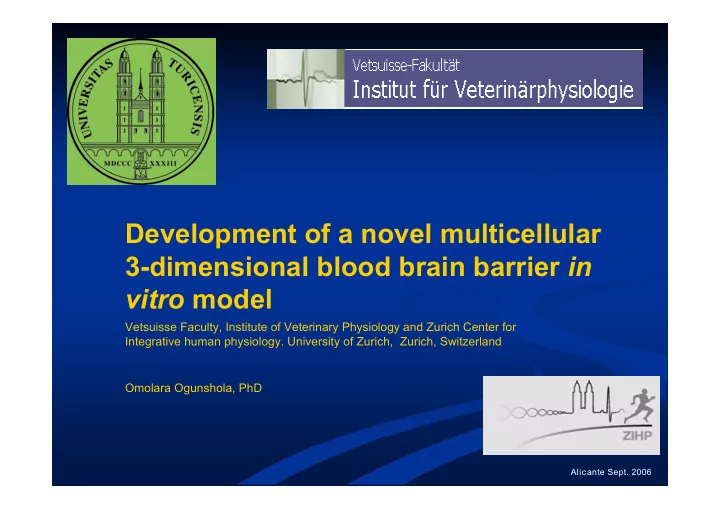

Development of a novel multicellular 3-dimensional blood brain barrier in vitro model Vetsuisse Faculty, Institute of Veterinary Physiology and Zurich Center for Integrative human physiology. University of Zurich, Zurich, Switzerland Omolara Ogunshola, PhD Alicante Sept. 2006
The blood brain barrier (BBB) protects the brain environment Consists mainly of 3 cells; • Endothelial cells • Astrocytes • Pericytes From Abbott 1989 Alicante Sept. 2006
• The complexity of the brain and location of the BBB has enabled us only little understanding of induction and formation of the BBB • Further signals that disrupt or modulate BBB function are poorly understood • Thus good simplified model systems of BBB are sorely needed. • Animal testing is difficult, invasive and requires many experiments • Interpretation of the results is often difficult REDUCE, REFINE and REPLACE (3Rs) In vitro modeling • 2D models are most common but are limited • 3D models less common and have various advantages Alicante Sept. 2006
Anatomy of cellular junctions in brain endothelial Anatomy of cellular junctions in brain endothelial cells cells Ang-1 VEGF Luminal (blood) face Tie2 Flk-1 PECAM-1 PECAM-1 Adherens junctions β cat Cadherin Cadherin Actin Tight ZO1 Occludin Occludin junctions Endothelial cell Abluminal (brain tissue) face Alicante Sept. 2006
Hypoxia-induced loss of barrier function is visualized by Hypoxia-induced loss of barrier function is visualized by delocalization of proteins involved in cell-cell contact delocalization of proteins involved in cell-cell contact 0h 24h 48h 1% O 2 PECAM-1 staining 0.1% O 2 10 � m 1% O 2 β -catenin staining 0.1% O 2 Alicante Sept. 2006
Technical approach Technical approach Modified Boyden chamber is used to measure transendothelial electrical resistance (TEER) in presence of astrocytes and pericytes. Contact model Non-contact model Cell culture Cell culture Rat brain endothelial cells (RBE4; Roux et al. 1994, J. Cell physiol.) Rat primary astrocytes (perinatal animals) Rat primary pericytes (12-16 week old rats) Alicante Sept. 2006
Hypoxia disrupts RBE4 tight junctions resulting in decreased TEER values Short term Long term Alicante Sept. 2006
Endothelial tight junction disruption is differentially modulated by astrocytes and pericytes. Short term Long term Alicante Sept. 2006
Conclusion • Endothelial cells are resistant to long term hypoxia • Astrocytes provide significant protection during hypoxic stress • Pericytes have a biphasic response to hypoxic exposure • Presence of all 3 cell types is only advantageous during long term stress. Alicante Sept. 2006
Alicante Sept. 2006
Why do we need a new 3D BBB model? Why do we need a new 3D BBB model? Answer: 2D models are limited • 2D model does not accurately reflect in vivo situation - Interactions between cells are different. • BBB consists of 3 cells not just 2 (pericytes overlooked) Alicante Sept. 2006
Novel 3-dimensional BBB model? Novel 3-dimensional BBB model? Advantages • Allow cell-specific interactions to occur that can be directly observed • Observe different stages of barrier formation - induction and maturation • Understand BBB function disruption (after hypoxic/oxidative stress) Disadvantages • No blood flow! • Rest of brain millieu absent Alicante Sept. 2006
Technical approach Technical approach cell suspension NaOH Spot droplets Acid soluble Basic insoluble collagen solution collagen solution Overlay with media Alicante Sept. 2006
RBE4 form tube-like structures in vitro in vitro RBE4 form tube-like structures 4 DIV 6 DIV 2 DIV Phase contrast Fluores- cence Endothelial cells (PECAM-1) in green Alicante Sept. 2006
RBE4 form tube-like structures in vitro in vitro RBE4 form tube-like structures Tie-2 (Angiopoeitin receptor) PECAM-1 (adhesion molecule) Alicante Sept. 2006
Imaging of RBE4 tube-like structures Imaging of RBE4 tube-like structures after sectioning show hollow tubes after sectioning show hollow tubes Endothelial cells (PECAM-1) in red Alicante Sept. 2006
Astrocytes interact with RBE4 tube-like interact with RBE4 tube-like Astrocytes structures in 3D culture structures in 3D culture Endothelial cells (PECAM-1) in red, astrocytes (GFAP) in green Alicante Sept. 2006
Astrocytes interact with RBE4 tube-like interact with RBE4 tube-like Astrocytes structures in 3D culture structures in 3D culture From Abbott 1989 Confocal image Endothelial cells (PECAM-1) in red, astrocytes (GFAP) in green Alicante Sept. 2006
How can we follow tube formation and cellular interactions in real time? Direct fluorescence with lipophilic fluorescent dye + DiI/PKH Alicante Sept. 2006
Live imaging of RBE4/astrocyte interactions using lipophilic dyes Endothelial cells in red, astrocytes in green Alicante Sept. 2006
Alicante Sept. 2006
Resolution after lipophilic-labeling is reduced compared to fixed imaging Live imaging in collagen droplet Double-staining in fixed (lipophilic dye) collagen droplet • Need to use confocal and 2-photon microscopy to get better images and to observe cells more closely. Alicante Sept. 2006
What about pericytes?? Pericytes survive in collagen and label with lipophilic dyes. Some interactions take place. Alicante Sept. 2006
Summary Developing a novel 3D model of BBB which can be observed in real-time. • Observe cell interactions • Stage-specific development • Can be subjected to hypoxic/oxidative stress to observe barrier breakdown • Other cells can easily be added to the matrix • Eventual in drug testing (alterations in cell interactions and movement)? Genetic profile analyses to identify cell-specific genes and signalling pathways that are modulated during the different stages of model stabilisation. Alicante Sept. 2006
Acknowledgements Abraham Al-Ahmad Prof. Max Gassmann (University of Zurich) Prof. Joseph Madri (Yale University) Alicante Sept. 2006
Alicante Sept. 2006
Tube formation depends Tube formation depends on collagen density on collagen density 2.5 mg/mL collagen 3.25 mg/mL collagen Alicante Sept. 2006
Astros/endos ratio is important for interactions 3:1 ratio 4:1 ratio Indirect fluorescence (endos in red and astros in green) Alicante Sept. 2006
RBE4 cells - Normoxia - Actin (Z-stack 10 plan - 18 µ m thickness) Z 3/10 Z 6/10 Z 9/10 Alicante Sept. 2006
Recommend
More recommend